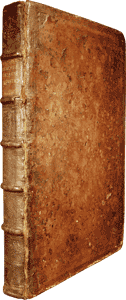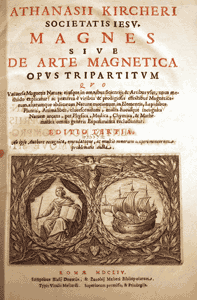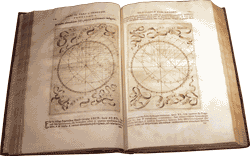| |
|

Athanasius Kircher
(1602-1680) |
This work contains all that was known in his
day on the subject of electricity and magnetism. While William
Gilbert's De magnete (1600), the first thoroughly modern treatment
of magnetism, influenced Kircher considerably, Kircher adapts
Gilbert's theories of magnetism and Kepler's work in astronomy,
but does not hesitate to refute either.
Kircher's Magnes is filled with curiosities,
both profound and frivolous. The work does not deal solely with
what modern physicists call magnetism. Kircher discusses, for
example, the magnetism of the earth and heavenly bodies; the
tides; the attraction and repulsion in animals and plants; and the
magnetic attraction of music and love. He also explains the
practical applications of magnetism in medicine, hydraulics, and
even in the construction of scientific instruments and toys. In
the epilogue Kircher moves from the practical to the metaphysical
(and Aristotelian) when he discusses the nature and position of
God: the central magnet of the universe.
|


Magnes
sive de arte magnetica opus tripartitum
Athanasius Kircher
1641 |
This work contains the first use of the term "electro-magnetism",
(page 640). This work, like others of Kircher's printed works,
became very popular. The Magnes had a powerful influence upon Otto
von Guericke, while Jungius, Leibniz and others quoted from
Kircher's works.
|
 |
The work is divided into three parts: the first
on the magnet itself; the second on its application (encompassing
magnetic statics, magnetic geometry, magnetic astronomy and
magnetic natural magic); and the third on such topics as the
magnetism of the earth and other heavenly bodies, the use of the
thermometer, natural and artificial weather, magnetism of
medicines, poisons and antidotes, the attractive force of the
imagination, and the magnetism of music and of love. Part III
contains a large section featuring the role of magnetism in
medicine, including a chapter on Tarantism, the Dancing Mania of
the middle ages caused by the bite of the tarantula, and centered
on the Italian city of Taranto (in Apulia). This section includes
a fine engraved plate of anatomical illustrations of the
tarantula. The disease is described and musical examples are
provided, including lyrics, musical instruments, and dance steps
used in effecting a cure.
Brigham Young catalogue 4; Brunet, III, p. 667;
Caillet, Manuel bibliographique des sciences psychiques ou
occultes, II, 362.5779; Clendening, Athanasius Kircher, 1602-1680:
an exhibition 5.4; De Backer, Bibliotheque des ecrivains.., I,
422-23.5; DSB, VII, pp. 374-378; Graesse, IV, 21; Haskell Norman
Library 1215; Krivatsy, NLM, 6398; Merrill 4; Mottelay,
Bibliographical history of electricity & magnetism, p. 120;
Poggendorf, I, 1259; Ronalds, Catalogue of books .. relating to
electricity, magnetism .. (1880), p. 267; Sommervogel, IV,
10048-49.6; Thorndike, VII, p. 269;
|
|